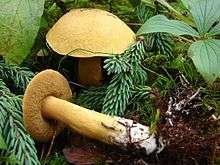Suillus tomentosus
| Suillus tomentosus | |
|---|---|
 | |
| Scientific classification | |
| Kingdom: | Fungi |
| Phylum: | Basidiomycota |
| Class: | Agaricomycetes |
| Order: | Boletales |
| Family: | Suillaceae |
| Genus: | Suillus |
| Species: | S. tomentosus |
| Binomial name | |
| Suillus tomentosus (Kauffman) Singer | |
Suillus tomentosus is a species of mushroom. The common names of the species are Blue-staining Slippery Jack, Poor Man's Slippery Jack, and Woolly-capped Suillus.
Description
The cap is pale to orange-yellow with grayish brownish or reddish tomentum. The tubes are yellow and become blue when bruised.[1] The stipe is grandular dotted and the color is similar to the cap.[2] The cap is scaly and has fibrillose. The spores are brownish when they are young.[3] The spore print is dark olive brown to brown.[4] The species stains fingers blue.[5] Suillus variegatus and suillus reticulatus are similar to this species.[3] The species can be distinguished between other species in this genus because fibrillose-scaly surface of the cap.[6]
Edibility
The mushroom may be edible to some while others may find its taste acidic even after cooking.[1] The species has been known to cause gastric upset such as diarrhea and vomiting.[7] The author David Arora said the species tastes the same as Suillus fuscotomentosus.[3] Arora also said that on a blandness scale, this mushroom ranks at the bottom. Arora reports that one collector stated the mushroom smells and tastes like Tootsie Rolls when dried.[8] The species have also been said to smell like almonds.[7] Consumers have to be careful that when they look for this species, that they be careful to distinguish this between other species that stain blue but are poisonous.[9]
Habitat
The species is commonly found in the Rocky Mountains of Idaho and the Pacific Northwest. It is less common in the lake states. The species fruits in the summer in the Rocky Mountains. Also, the species fruits in autumn along the Pacific coast and in the lake states.[1] The species is by itself or scattered in mixed forests.[10] The species can commonly be found under lodgepole pines or other two-needle pines. It is rarely found under jack pines.[7]
Suillus tomentosus forms tuberculate ectomycorrhizae (mycorrhizae that are nodular) with lodgepole pine (Pinus contorta var. latifolia). Recent work has shown that acetylene is reduced by the nodules which means that nitrogen is being fixed by bacteria within the nodules.[11][12] This system is functionally similar to the root nodules in legumes like clover. Lodgepole pine can be found growing on gravel pits or other extremely nitrogen deficient soils. Lodgepole pine with its S. tomentosus symbiont is one of the most common pioneer species in northern forests. It colonizes highly disturbed soils and creates an environment suitable for other species to colonize.
See also
References
- 1 2 3 H. Smith, Alexander (1974). The Mushroom Hunter's Field Guide. The University of Michigan Press. p. 86.
- ↑ Trudell, Steve; Ammirati, Joe (2009). Mushrooms of the Pacific Northwest: Timber Press Field Guide. Timber Press. pp. 224–225. ISBN 978-0-88192-935-5.
- 1 2 3 Arora, David (1986). Mushrooms demystified: a comprehensive guide to the fleshy fungi. Ten Speed Press. p. 505. ISBN 978-0-89815-169-5.
- ↑ "SUILLUS TOMENTOSUS". MykoWeb. Retrieved 2010-01-28.
- ↑ Multiple authors (2000). North American boletes: a color guide to the fleshy pored mushrooms. Syracuse University Press. p. 255. ISBN 978-0-8156-0588-1.
- ↑ "SUILLUS TOMENTOSUS". MykoWeb. Retrieved 29 January 2010.
- 1 2 3 K. Miller, Orson; Miller, Hope (2006). North American mushrooms: a field guide to edible and inedible fungi. Globe Pequot. p. 359. ISBN 978-0-7627-3109-1.
- ↑ Arora, David (1991). All That the Rain Promises and More: A Hip Pocket Guide to Western Mushrooms. Ten Speed Press. p. 178. ISBN 978-0-89815-388-0.
- ↑ Multiple authors (1998). A Field Guide to Mushrooms: North America. Houghton Mifflin Harcourt. p. 208. ISBN 978-0-395-91090-0.
- ↑ Multiple authors (1997). The Macrofungus Flora of China's Guangdong Province. Chinese University Press. p. 471. ISBN 978-962-201-556-2.
- ↑ Paul, L.R.; Chapman, B.K.; Chanway, C.P. (2007). "Nitrogen Fixation Associated with Suillus tomentosus Tuberculate Ectomycorrhizae on Pinus contorta var. latifolia". Annals of Botany. 99 (6): 1101–1109. doi:10.1093/aob/mcm061. PMC 3243579
 . PMID 17468111.
. PMID 17468111. - ↑ , Paul, Chapman and Chanway, Can. J. For. Res. Vol. 36, 2006.
External links
| Wikimedia Commons has media related to Suillus tomentosus. |